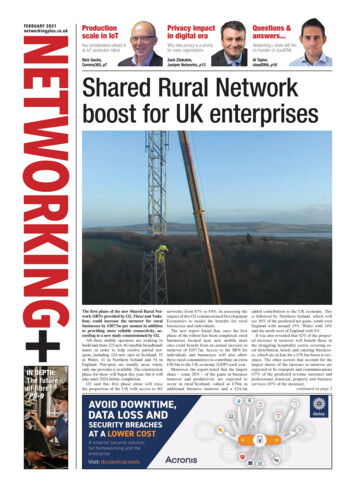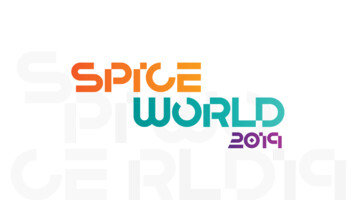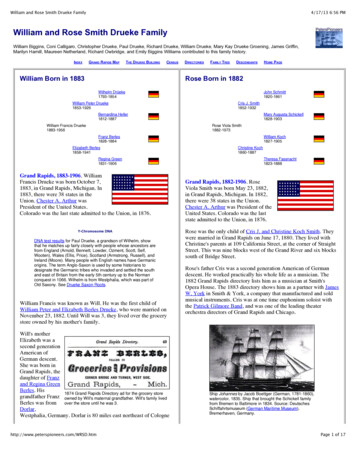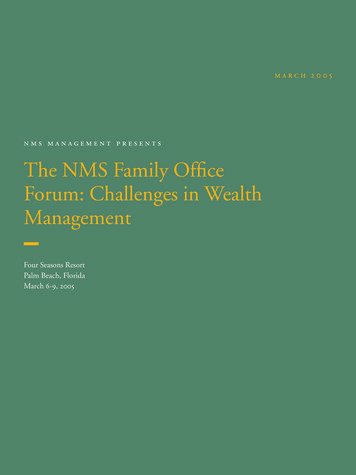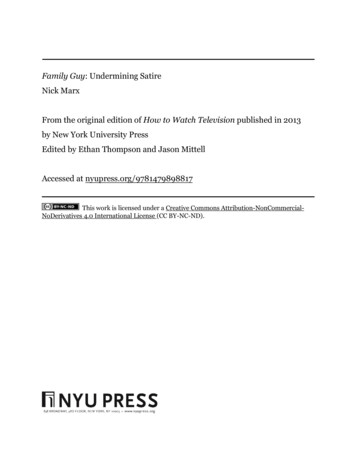
Transcription
Family Guy: Undermining SatireNick MarxFrom the original edition of How to Watch Television published in 2013by New York University PressEdited by Ethan Thompson and Jason MittellAccessed at nyupress.org/9781479898817This work is licensed under a Creative Commons Attribution-NonCommercialNoDerivatives 4.0 International License (CC BY-NC-ND).
19Family GuyUndermining SatireNick M a r xAbstract: With its abrasive treatment of topics like race, religion, and gender, Family Guy runs afoul of critics but is defended by fans for “making fun of everything.”Nick Marx examines how the program’s rapid-fre stream of comic references caters to the tastes of TV’s prized youth demographic, yet compromises its satiricpotential.Te Family Guy episode “I Dream of Jesus” (October 5, 2008) begins with thetype of scene familiar to many fans of the series. Peter and the Grifn familyvisit a 1950s-themed diner, one that accommodates a number of parodic references to pop culture of the era. In a winking acknowledgment of how Family Guy(FOX, 1999–2002, 2005–present) courts young adult viewers, Lois explains to theGrifn children that 1950s-themed diners were very popular in the 1980s, wellbefore many of the program’s targeted audience members were old enough to remember them. As the Grifns are seated, they observe several period celebritylookalikes working as servers in the restaurant. Marilyn Monroe and Elvis passthrough before the bit culminates with a cut to James Dean “afer the accident,”his head mangled and his clothes in bloodied tatters. But, in characteristic Family Guy narrative logic, the episode stufs more comedic fodder into the premise.Cleveland Brown, the good-natured black character of the cohort, enters the restaurant only to be blasted away by police ofcers with a fre hose and attack dogs.“Oh, that takes me back,” Cleveland fatly remarks afer being expelled from therestaurant.Te scene works according to the comedic logic of the “rule of three,” settingup the gag’s structure with Marilyn Monroe, reinforcing it with Elvis, and, fnally,breaking the pattern in an unexpected way with James Dean. At frst glance,Cleveland would simply seem to be further elaboration of the original joke, an1779780814745311 thompson text.indd 1777/16/13 3:29 PM
178Nick Marxextra punchline characteristic of the show’s edgy approach to humor. But one ofthese punchlines is not like the others. By trotting out Monroe, Elvis, and Dean—all of whom died ignominiously—Family Guy makes fun of the supposed virtuousness commonly seen in cultural hagiographies like Time-Life’s Rock & RollGeneration: Teen Life in the 50s and Te American Dream: Te 50’s. Cleveland’sinclusion, however, jarringly places celebrity scandal alongside civil rights confict in the scene’s range of comedic targets, suggesting that both are safely partof a past about which it is now permissible to joke. Tis has become the show’smodus operandi: everything from television sitcoms to advertising mascots tosystemic social inequalities are lampooned within a rapid-fre feed of fashbacks,cutaways, and perfunctory plot events. But is it all equally funny?Tis question pervades much of the popular dialogue about Family Guy. Fansdefend scenes like the one described above as “just a joke,” while interest groupslike the Parents Television Council protest that the program goes too far all tooofen. But before rushing to judgment, careful analysis of the show’s industrialand aesthetic contexts helps us better to account for the wide range of responsesit elicits. Te question, then, might not be “Is Family Guy funny?” but “How andfor whom does Family Guy create humor?” In many ways, Family Guy refectstelevision’s present proliferation of comedic modes of social engagement. Situation comedies continue to dominate reruns, Te Daily Show with Jon Stewart flters the news through comedic satire, and even the appeal of many reality showsis based on taking a schadenfreude-like pleasure in seemingly “real” scenarios.Te humor of Family Guy shares similarities with these comedies, but its diferences from them point to shifs in the ways we watch and understand television.Family Guy is emblematic of what might be called a growing “click culture,” theaesthetic and industrial practices of comedy that are both creating and created bytelevision networks’ expansion online, increased user-control of television content,and the integration of that content into social networking practices. Te television industry strives to create as many iterations of Family Guy as possible, allowing loyal viewers to interact with the show through merchandising, spin-ofs, andweb forums, as has become a standard practice for many shows today. Aesthetically, however, Family Guy departs from many of its generic brethren by structuringmost of its humor and episode plots around the unpredictable, non-sequitur natureof click culture. Te program’s compulsive habit of targeting—through fashbacks,cutaways, and narrative digressions—elements outside the Quahog storyworld giveit both a distinct comedic voice and a problematic mode of representing and reproducing power relations. Indeed, animated sitcoms from Te Flintstones to Te Simpsons to South Park have made strategic use of refexivity and extra-textual referencesfor satiric purposes, but none to Family Guy’s extent. And when the jokes pile up soquickly, the program’s ability to create meaningful satire becomes compromised.9780814745311 thompson text.indd 1787/16/13 3:29 PM
Family Guy179If we remain critically aware of this dynamic—if we recognize that there is adiference between joking about a celebrity death and joking about the violentracist oppression of millions of Americans—we see how Family Guy representsdominant views about new comedic tastes being cultivated by the technology andlifestyles available to young viewers today. As the television industry has movedaway from courting broad audiences by programming shows with mass appeal,it has been increasingly willing to risk alienating certain audience segments inorder to target others. In the contemporary era of digital convergence and transmedial movement of television content, the most valuable target audience hasbecome young men aged 18–34. In addition to discretionary spending and trendsetting powers, this demographic is seen as susceptible to the siren song of nontelevision media like video games and the Internet. Tese “lost boys,” as Wireddubbed them in 2004, “hunger for ‘authenticity’,” and “like things fresh, unpredictable, and uncensored.”1 Resistant to television mainstays like thirty-secondadvertisements and conventional sitcoms, these viewers instead seek content thatfatters their media hyper literacy and (self-declared) hip sensibilities.Accordingly, the television industry has made every efort to bring these“lost boys” back into the fold. Cable channels like G4 target young men withprograms about Internet trends, while Spike has staged an annual awards showfor video games since 2003. Broadcast networks package television spots withadvertising opportunities across their web and cable holdings, acknowledgingthat viewers—particularly young men—increasingly consume media in a multiscreen environment. In the industrial practices of click culture, these trendshave been particularly acute. Comedy Central’s Tosh.0 pairs viral videos withcomedic commentary, accompanied by frequent exhortations from host DanielTosh to engage with the program in a variety of digital media and live performances. Cartoon Network and HBO have also developed comedic televisionprograms from the Webby award-winning Children’s Hospital and FunnyorDie.com, respectively.Te low development costs of many comedic formats, along with viewers’ ability to consume them in bite-sized chunks, make them amenable to the transmedialstrategies of distribution and consumption so prevalent today. Family Guy embracesthese practices, having spawned a number of spin-ofs and ancillary products invideo games, merchandising, and home video. Moreover, comedy—from Te Simpsons to Beavis & Butt-Head to South Park—has always articulated an “edgy” appealdirected at the young-male demo, but Family Guy has pushed this risqué sensibilityto new limits. Before uncritically accepting the pairing of Family Guy and youngmale viewers as a successful strategy, however, we need to consider what this industrial practice leaves out. Tat is to say, not all males aged 18–34 (let alone viewers of Family Guy outside this age group) share the same racial, ethnic, or sexual9780814745311 thompson text.indd 1797/16/13 3:29 PM
180Nick Marxidentity, come from a similar socio-economic background, or even have equal access to the technologies driving transmedial mobility. Te growing danger of clickculture as seen in the aesthetic and industrial practices of Family Guy is that it canreinforce the social power of already powerful audience categories, further excluding historically marginalized viewers whose tastes might not match the industry’sdemographic assumptions. How exactly, then, does click culture function, and howdoes Family Guy articulate these practices?Tink of reading the rapid-fre stream of jokes in Family Guy in much the sameway you do items in a Facebook or Twitter feed. At any given time of day, youmight encounter a friend posting a link to a tawdry gossip column, immediatelyfollowed by another friend who posts a link to a petition asking for signaturesin an upcoming recall election. Te respective roles that these two items play inyour life are not as diferent as you might like to think, and both are brought toyou by an information delivery mechanism that presents the stories contiguously.But clicking through to engage further with them requires diferent, though notmutually exclusive, critical sensibilities. Te gossip column might be somethingyou quickly repost for friends to see; the recall petition might inspire you to contact your neighbors and join a local rally. Facebook and Twitter do little to distinguish between the two items, but each inspires a range of uses. Even when eventsfrom the two seemingly disparate domains of politics and pop culture collide—asthey do whenever a politician is caught in a sex scandal—we implicitly understand that there is no necessary connection between them.Instead of afording consumers a similar range of responses to information andentertainment discourses, Family Guy fattens their signifcance to the same leveland naturalizes their meaning under the aegis of everything being “just a joke.”Where social networking sites loosely organize disparate stories for users, FamilyGuy reproduces the aesthetic experience of newsfeed navigation and organizes itmuch more rigorously according to the logic that everything appearing onscreenis equally capable of being lampooned. Tis aesthetic is driven by contemporarytelevision’s economic imperative, one that (in the case of Family Guy) places morevalue on the commodity audience of 18–34-year-old males and thus prizes thisgroup’s presumed response more than that of other audiences. But the quick-hitaesthetics of click culture programs like Family Guy belie their industrial motivations, creating the illusion that all audiences can fnd everything equally funnyand constructing a false sense of comedic pluralism that elides the power differentials among comedic targets and audiences. In doing so, Family Guy rarelytrades in critical takedowns of the powerful by the powerless—the very goal ofsatire; instead, it tends to reafrm the politics of the status quo.In one example from the episode “No Meals on Wheels” (March 25, 2007), Peter isannoyed at Mort Goldman’s requests to borrow his personal belongings, calling him9780814745311 thompson text.indd 1807/16/13 3:29 PM
Family Guy181a “bigger mooch than the Mexican Super Friends.” Te ensuing cutaway begins withan exterior shot of the “Mexican Hall of Justice,” a parodic reiteration of the headquarters of the Saturday morning cartoon Super Friends (ABC, 1973–1986), a showperfectly in tune with Family Guy’s fxation on the American television heritage.As the scene moves into the hall, we see dozens of anonymous Mexican charactersdressed in superhero garb milling around, with “Mexican Superman” conspicuouslylazing with a beer and his feet up. A white landlord enters and confronts him aboutthe number of people living in the hall, initiating a short vignette in which he and“Mexican Batman” deceive the landlord and defuse a prospective eviction.Te ostensible gag of the cutaway, running just over thirty seconds, is that theSuper Friends’ Hall of Justice is as overcrowded as a typical Mexican home, andthe bit evokes a number of commonly circulated stereotypes about Latino/a populations in the United States as indolent, duplicitous, and freeloading. Moreover,the images play with the longstanding representational tradition in Hollywoodflm and television of caricaturing Latino/as as stock types like the “bandido” and“Latin lover.”2 Whereas this tradition ofen placed caricatured representationsof marginalized groups within the narrative—by having the white cowboy defeat the sneaky bandido, for example—Family Guy compulsively directs our attention beyond the narrative by recreating the aesthetic experience of newsfeednavigation that it presumes its “lost boy” audience enjoys. In our above example,the Mexican stereotypes are not contextualized, undermined, or reinforced withany clarity in the episode. Instead, they become one of any number of referentsplucked from the pop cultural ether and placed alongside another one—the SuperFriends—in the creation of a cutaway gag. Tis practice elides the history of thestereotypes and the vast power diferentials between the two referents, suggestinginstead that both are simply fodder for jokes. In doing so, Family Guy naturalizesthe notion that its audience’s everyday lived experience is one in which everyoneand everything is capable of being made fun of.Indeed, Family Gu
Family Guy episode “I Dream of Jesus” (October 5, 2008) begins with the type of scene familiar to many fans of the series. Peter and the Grifn family visit a 1950s-themed diner, one that accommodates a number of parodic refer-ences to pop culture of the era. In a

